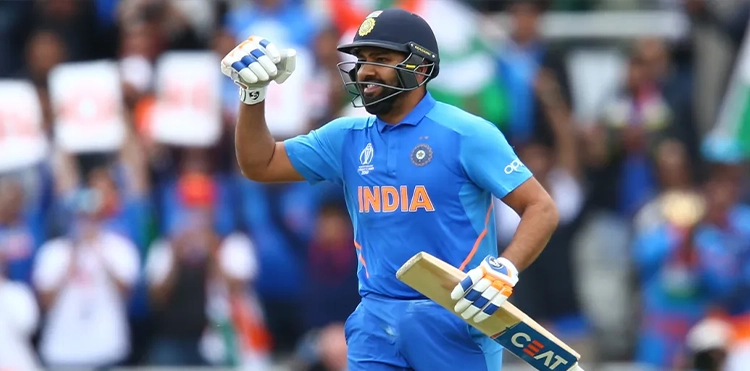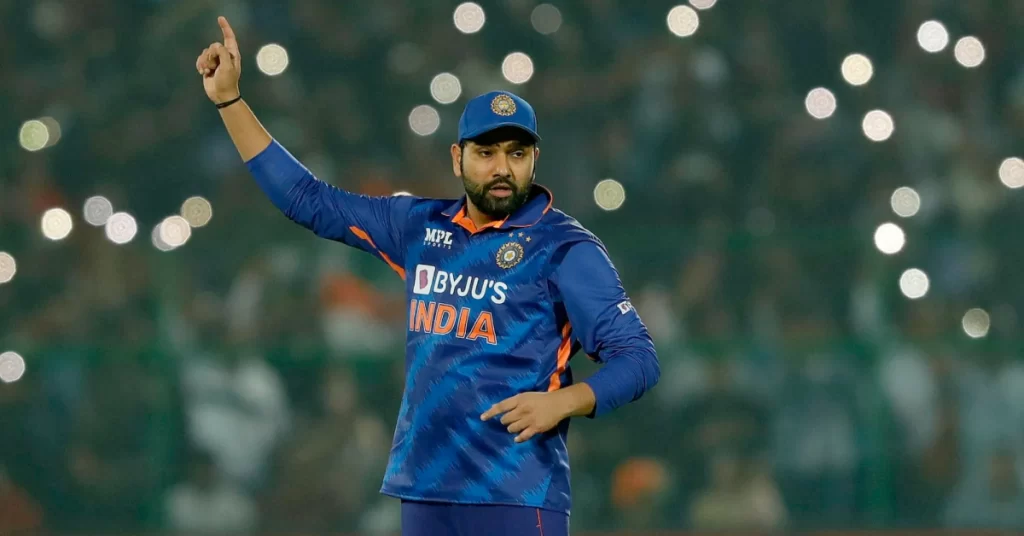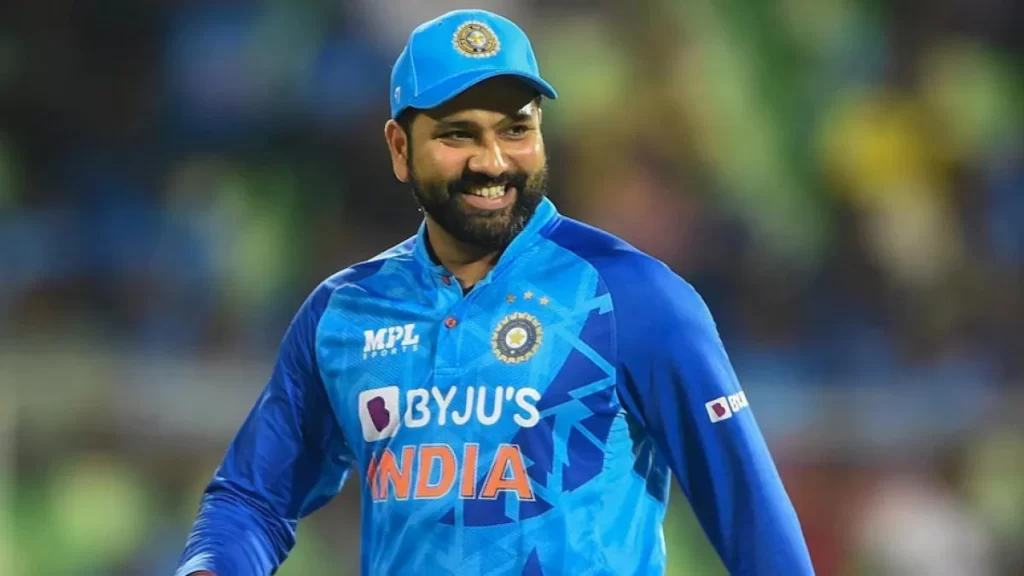Rohit Sharma has been associated with the term “talent” for a long time, which has sometimes been a source of distress for him. The cricketing community has imposed this label on him, and after spending over a decade in the national team, he feels burdened by it.
Personal Information
| Name | Rohit Sharma |
| Born | April 30, 1987 (35 years) |
| Birth Place | Nagpur, Maharashtra |
| Height | 1.7M |
| Role | Batsman |
| Batting Style | Right-Handed Bat |
| Bowling Style | Right-Arm offbreak |
ICC Ranking
| Role | Test | ODI | T20 |
| Batting | – | 9 | – |
| Bowling | – | – | – |

Career Information
| Teams | India, Deccan Chargers, India A, India Green, India U19, Mumbai, Mumbai Indians, Indians, India Blue, Board Presidents XI |
Batting Career Summary
| M | INN | NO | Runs | HS | Avg | BF | SR | 100 | 200 | 50 | 4s | 6s | |
| Test | 49 | 83 | 9 | 3379 | 212 | 45.66 | 6040 | 55.94 | 9 | 1 | 14 | 361 | 69 |
| ODI | 243 | 236 | 34 | 9825 | 264 | 48.64 | 10914 | 90.02 | 30 | 3 | 48 | 899 | 275 |
| T20I | 148 | 140 | 15 | 3853 | 118 | 30.82 | 2767 | 139.25 | 4 | 0 | 29 | 348 | 182 |
| IPL | 227 | 222 | 28 | 5879 | 109 | 30.3 | 4526 | 129.89 | 1 | 0 | 40 | 519 | 240 |
Bowling Career Summary
| M | INN | B | Runs | Wkts | BBI | BBM | Econ | Avg | SR | 5W | 10W | |
| Test | 49 | 16 | 383 | 224 | 2 | 1/35 | 1/35 | 3.51 | 112.0 | 191.5 | 0 | 0 |
| ODI | 243 | 38 | 593 | 515 | 8 | 2/27 | 2/27 | 5.21 | 64.38 | 74.12 | 0 | 0 |
| T20I | 148 | 9 | 68 | 113 | 1 | 1/22 | 1/22 | 9.97 | 113.0 | 68.0 | 0 | 0 |
| IPL | 227 | 32 | 339 | 453 | 15 | 4/6 | 4/6 | 8.02 | 30.2 | 22.6 | 0 | 0 |
Career Information
| Test Debut | vs West Indies at Eden Gardens, Nov 06, 2013 |
| Last test | vs Australia at Narendra Modi Stadium, Mar 09, 2023 |
| ODI debut | vs Ireland at Civil Service Cricket Club, Jun 23, 2007 |
| Last ODI | vs Australia at MA Chidambaram Stadium, Mar 22, 2023 |
| T20 debut | vs England at Kingsmead, Sep 19, 2007 |
| Last T20 | vs England at Adelaide Oval, Nov 10, 2022 |
| IPL debut | vs Kolkata Knight Riders at Eden Gardens, Apr 20, 2008 |
| Last IPL | vs Delhi Capitals at Wankhede Stadium, May 21, 2022 |
Profile
Rohit Sharma has been associated with the term “talent” for a long time, which has sometimes been a source of distress for him. The cricketing community has imposed this label on him, and after spending over a decade in the national team, he feels burdened by it.

There have been whispers in the domestic cricket scene about a Mumbai teenager’s effortless and free-flowing stroke-play, as mentioned by Harsha Bhogle. Coaches and scouts have taken notice of him, and he has performed exceptionally well in first-class cricket with an average of over 50. He gained widespread attention when he scored an unbeaten triple-hundred at the Ranji level.
The story of Rohit Sharma’s rise to fame began with an injury to Yuvraj Singh during the 2007 World T20. Rohit Sharma was called upon as a last-minute replacement to play a league game against the hosts. Despite a slow start to the Indian innings, the 20-year-old showed remarkable composure and stroked his way to a fluent half-century against the likes of Pollock, Ntini, and Morkel. He displayed impressive maturity under pressure and batted till the end of the innings, helping India reach a respectable total. India ultimately defended the total, knocking South Africa out of the tournament on their home turf.
Indian cricket fans have a tendency to look for like-for-like replacements, especially when it comes to spotting similarities with past players. They are obsessed with statistics and often feel nostalgic when they see an elegant-looking batsman with a free-flowing batting style from Mumbai. Rohit Sharma was considered to be the long-destined successor to the great Sachin Tendulkar at number 4 in the Test batting line-up. This was due to his ability to play shots with ease, even against express pace, and his wide range of shots. Many believed that he was God’s gift to cricket in the post-Tendulkar era.
After his impressive performances in the World T20 and his remarkable record in the Ranji Trophy, Rohit was selected for the ODI team on a whim. He made a mark in the CB series in Australia, playing crucial cameos against renowned bowlers like Brett Lee and Stuart Clark, as well as a competent Sri Lankan attack. These performances caught the attention of the selectors and earned him an extended run with the limited-overs side.
Despite his talent, Rohit Sharma struggled to maintain consistency and often gave away his wicket. Critics pointed out that he had too many shots for the same ball, leading to issues with shot selection. Additionally, experts noticed that his stance was too side-on, making it difficult for him to play the short ball without a back-and-across trigger movement. His batting average of 22, along with a series of low scores and unconverted starts, prevented him from securing a spot in the 2011 Cricket World Cup squad.

Rohit Sharma owes a lot to the Indian Premier League for keeping him in the reckoning and preventing him from being discarded like many other young and talented cricketers who failed to make it big at the highest level. In the first two years of the IPL, he performed exceptionally well for the Deccan Chargers, scoring over 350 runs each time and proving his worth to the franchise. He was later transferred to the Mumbai Indians franchise in 2011, where he has been one of their most consistent batsmen over the years.
Despite being given numerous opportunities, Rohit Sharma struggled to establish himself in the Indian cricket team due to the well-established middle-order. He continued to move in and out of the Indian eleven. However, his luck took a turn for the worse when he was on the verge of receiving the coveted India cap during the Nagpur Test against South Africa in 2010. He suffered a heartbreaking injury during a warm-up football game and was ruled out of the series. This was a gut-wrenching turn of events for him, and he had to wait for another four years to prove his Test credentials.
In 2011, Rohit Sharma performed well in the IPL and was selected for the ODI squad for the West Indies tour. He scored three half-centuries in five matches, but unfortunately, his success was short-lived. He struggled in the CB series in Australia and had a difficult tour of Sri Lanka, scoring only 14 runs in 5 innings with 2 ducks. Despite being given many opportunities, Rohit was starting to be known as a player who was both frustrating and fascinating.
Despite being known for their fickleness, the selectors surprisingly continued to support him. As there were no other strong contenders for the opener’s position in ODIs, the Indian captain MS Dhoni decided to give him a chance as an opener in the limited-overs format.
The term “masterstroke” has often been used in a vague, result-based manner, making it somewhat of an enigma. However, promoting Rohit Sharma to the top of the order proved to be a true masterstroke. India finally found a strong candidate for the opener’s spot, and Rohit was able to turn his career around after almost five years of being in and out of the side.
As an opener, Rohit Sharma had enough time to play himself in and formed a formidable partnership with Dhawan, playing a significant role in India’s unbeaten and successful Champions’ Trophy campaign in 2013. Despite being labeled as talented, Rohit finally started to live up to the tag. In a high-scoring ODI series against Australia, Rohit scored an impressive 491 runs in six matches, including a stunning 209 in the deciding ODI in Bangalore. This achievement put him in an elite list of ODI double-centurions that included Sachin Tendulkar and Virender Sehwag.
Following the retirements of Rahul Dravid and VVS Laxman, the Indian team needed to develop a new group of Test batsmen. This presented an opportunity for Rohit, who finally earned his India Test cap during the West Indies series at the Eden Gardens.
In his debut innings, Rohit Sharma scored an impressive 177, which helped shift the momentum in India’s favor. He followed this up with an unbeaten 111 in the next Test, which was Sachin Tendulkar’s farewell match. After an injury break, Rohit returned to the field with a vengeance, scoring a remarkable 264 against Sri Lanka in an ODI at the Eden Gardens. This score was thirteen runs higher than the entire Lankan team’s score. Rohit’s performances were a clear message to the selectors that he was ready to take on the challenge of being a Test batsman.
However, a concerning pattern emerged when he was selected for the tour to Australia after his impressive performance in Kolkata. He was being chosen for away Test tours based on his white ball performances in less challenging conditions. Despite scoring 209 in South Africa in late 2013, he struggled in seaming conditions and appeared technically inadequate.
Rohit Sharma committed to the line of the ball too early and played as if it were a true wicket, which was a strength in ODIs but a weakness in Test matches. Similarly, he was picked for the tour of Australia after scoring 264, but he only managed to make one fifty in 6 innings. He struggled against the pace-heavy Australian attack, continuously playing away from the body and trying to hit through the line in conditions that favored lateral movement. He also showed poor off-stump awareness.
Despite the odds, he maintained his impressive performance in ODIs and finished the 2015 World Cup campaign as India’s second-highest run-scorer, with a total of 330 runs. He scored a century in the quarter-final against Bangladesh, in addition to two fifties.
In early 2016, Rohit Sharma, the ODI player, finally proved himself as an opener with an outstanding limited-overs tour of Australia. He scored back-to-back hundreds and a 99 in the series, finally justifying the faith of the selectors and his captain.
Rohit Sharma had become a dominant force in one-day cricket, starting his innings slowly but accelerating once he was set. During an extended home season, Rohit Sharma also improved his Test game, playing closer to his body and avoiding the pitfalls of his ODI technique. He finished the season with four fifties and a hundred in his last five innings, culminating in an unprecedented third ODI double-century against a weak Sri Lankan attack.
Rohit Sharma’s exceptional technique and graceful style of play have helped him achieve consistency, making him a regular member of the Test set-up since 2018. In 2019, he reached new heights in white-ball cricket by becoming the highest run-scorer in the ODI World Cup in England, scoring 648 runs from 9 games at an average of 81, including 67 fours and 14 sixes.
When Virat Kohli stepped down as T20I captain just before the 2021 T20 World Cup, Rohit Sharma was the clear favourite to take over the role. Later, he was named the ODI skipper for the tour of South Africa 2021-22, but unfortunately, he missed the entire tour due to injury. However, he assumed full-time captaincy in India’s 1000th ODI in Ahmedabad against West Indies on 06 February 2022. A few weeks later, as expected, Rohit took over the Test captaincy from Kohli and led India to series wins over Sri Lanka and Bangladesh (and drew the series with England in England 2021-22) so far (as of March 2023).
IPL through the years
Rohit Sharma’s career has been greatly impacted by the IPL. As a young and talented batsman struggling with consistency, the IPL provided him with an opportunity to stay relevant. He made the most of this chance during his time with the Deccan Chargers from 2008-2010, scoring over 350 runs in each of the three seasons. Later, he returned to his hometown of Mumbai through the IPL, which made him very happy. From 2011-2013, his statistics with the Mumbai Indians improved progressively, and his best IPL season in 2013 – where he finished the tournament with 538 runs – coincided with MI’s first title win.
Additionally, the IPL has revealed Rohit Sharma’s leadership qualities, which have impressed many. He has led the Mumbai Indians to an incredible five IPL titles, which is a remarkable achievement. Furthermore, Rohit Sharma is one of the highest run-scorers in the history of the IPL, trailing only Virat Kohli and Shikhar Dhawan.
Get IPL 2023 Live Score along with Points Table & Schedule Updates at IceCric.News and Follow for Live Updates – Twitter, Facebook & Instagram.




